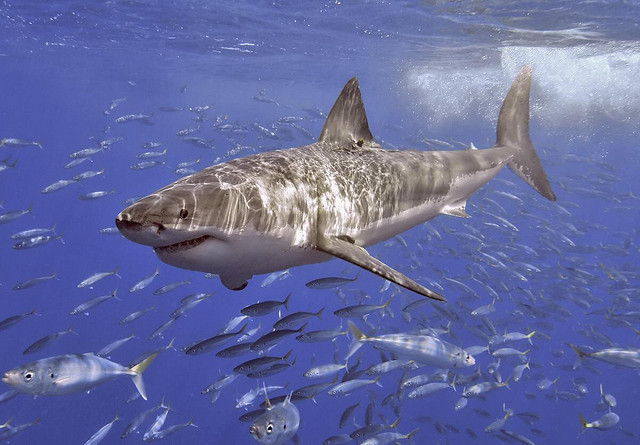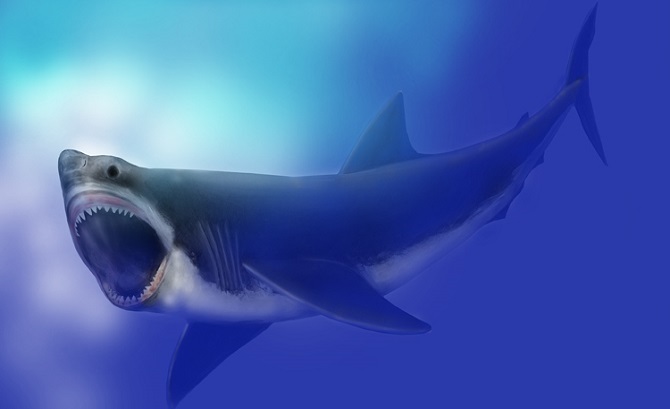
The white shark grin. She definitely knows something we don’t. Image: Flickr / Pterantula
Sometimes the internet goes a little crazy with quirky, fantastical, scary stories. Take for example the recent hoax, ‘huge sting ray attacks man’, which turned out to be a great video of a man diving around the shadow of a kite.
So, what can we make of the mysterious discovery of a CSIRO shark tag washed up on a beach that had some fairly typical data recorded on it? Some are incorrectly interpreting the data and speculating that this is evidence of the existence of a megalodon, an ancient extinct species of shark that lived millions of year ago. The megalodon was huge, around 15-24 metres in length… eek. White sharks grow up to 6 m in length.
People want to know the truth about the shark-eating-shark, so here it is.

An artist rendering of a megalodon.
In late 2003 we tagged a white shark approximately 3m in length off south-west Western Australia with a tag that collects data on swim depth, water temperature and light levels. The tag records data at regular intervals against a date/time stamp. The tag was programmed to release from the shark on a pre-programmed date, float to the surface and transmit the data collected back to us via satellite. These ‘archival’ tags are commercially produced and are in common use by researchers around the world.
The tag surfaced approximately two weeks earlier than programmed, in early 2004. This is not unusual. It washed ashore near Esperance, WA and was returned to us.
When we looked at its data there was a period of approximately three weeks just before the tag surfaced where the temperature recorded was higher than the surrounding sea, but where the tag continued to ‘dive’ in a pattern consistent with a white shark. During this time, the tag failed to record light. Data before and after suggest the tag was functioning normally. The temperature recorded for these three weeks was consistent with that of the core body temperature of a white shark but too low for something like a killer whale.
At one point the tagged shark dived to a depth of 570 m – this is not unusual for white sharks – it is normal behaviour. This dive took place about one week prior to the tag recording the higher temperatures (not immediately before as some have reported) and the two events are not related.
All evidence suggests that the tag had been eaten by another white shark.
We have seen white sharks biting each other before, sometimes removing pieces of tissue in the process. We concluded that this was the most likely explanation – One shark bit off a little more than he could chew and ended up swallowing the tag.
We never concluded that the 3m shark was consumed by another much larger shark.
And that folks, is the truth.
White shark fast facts:
- A common mistake people make is calling these awesome creatures, ‘Great White Sharks’, it’s actually just ‘white shark’ (Carcharodon carcharias). But we still think they’re still pretty great.
- Sharks play a vital ecosystem role as top predators. Declines in top predators can cascade through the food web, seeing some species groups increase while eliminating others.
- We have one of the most comprehensive white shark research programs in the world, with over 250 tagged white sharks in Australian waters.
- Our tagging program provides us with a good idea of migration patterns – we know for example that there is an East and a Southwest population.
- We tag these beauties in a very humane way – in a sling, in the water:
- The white shark is listed as vulnerable and migratory under the Environment Protection and Biodiversity Conservation Act 1999
- We are working with government and other partners to find out the population of white sharks in the east and southwest of Australia, we’re using tagging, aerial surveys and DNA analysis and advanced statistics.


2nd July 2014 at 11:48 am
And the W.A. govt, great conservators that they collectively are, have only just stopped short of setting a bounty on them , ( remember Wedge tail Eagles ?) doing a search and destroy last summer after a couple of unfortunate swimmers got reprocessed. Correct me if I’m wrong . Enter the ocean, and you enter the food chain.
Jaguar Shark as elusive as the Luminous Electric Jellyfish, IIRC.
2nd July 2014 at 11:06 am
There was a somewhat overwrought whodunnit style documentary that screened on the ABC last year that I’m pretty sure was based on this very incident…
14th June 2014 at 1:54 am
The Jaguar Shark, case closed.
13th June 2014 at 9:42 pm
what’s impressive to me is that you set the tag in the shark of the coast of WA and the tag washed ashore off the coast of Queensland; did I read that correctly?
16th June 2014 at 3:21 pm
Hey ATL – we corrected the blog, sorry! It washed ashore near Esperance, WA and was returned to us. Good pick up, thanks.
12th June 2014 at 6:18 am
OBVIOUSLY the shark was not eaten by a megalodon. That’s RIDICULOUS.
It was the Kraken.
Nothing you say will convince me otherwise.
14th June 2014 at 2:01 am
Na it was my hungry guppy for sure I saw it happen truely
14th June 2014 at 2:34 am
^^^ Win.